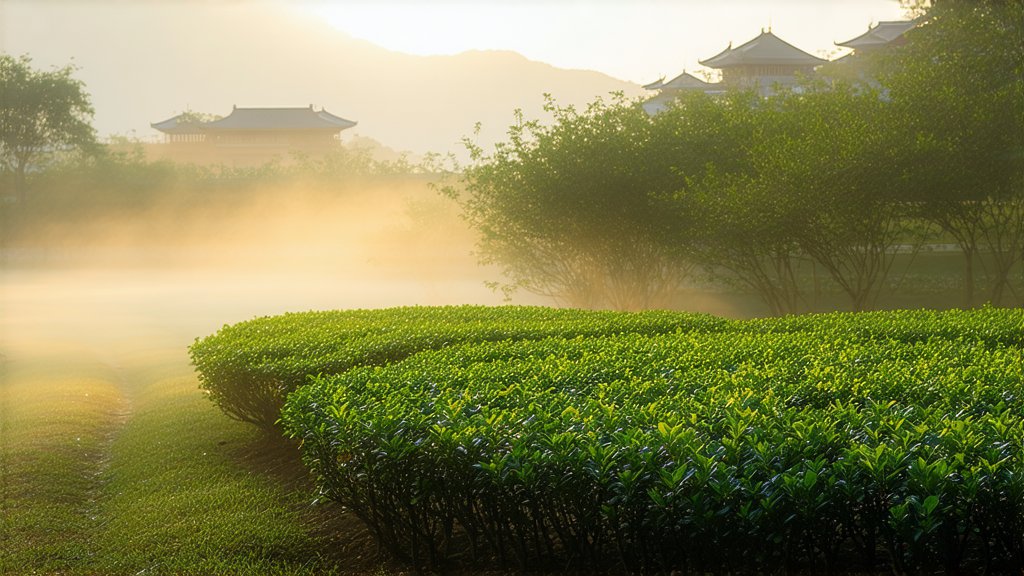
In the vast and diverse landscape of Chinese tea culture, few treasures hold as much mystique and allure as Junshan Yinzhen, a revered variety of yellow tea that hails from the misty mountains of Hunan Province. This exquisite beverage, often referred to as "King of Yellow Tea," is not only a testament to centuries-old traditions but also stands as a symbol of China's rich tea heritage and its unparalleled mastery in tea cultivation and processing.
A Glimpse into History
The origins of Junshan Yinzhen trace back over a millennium to the Tang Dynasty (618-907 AD), during which it was first cultivated on Junshan Island, nestled within Dongting Lake. Revered for its unique flavor profile and health benefits, this tea quickly gained favor among emperors and scholars alike, becoming an integral part of court life and high-level social gatherings. Its name, "Junshan Yinzhen," translates to "Precious Needle of Junshan," reflecting both its place of origin and the delicate, needle-like appearance of its leaves.
Throughout history, Junshan Yinzhen has been associated with various legends and folklore, further enhancing its mystique. One popular tale recounts how the tea was discovered by a poor farmer who, after witnessing a miraculous event involving a dragon and phoenix, found his tea plants transformed into ones producing the finest yellow tea leaves. Whether fact or fiction, such stories contribute to the enchanting aura surrounding this golden delicacy.
Varieties and Classification
Junshan Yinzhen falls under the category of Huangcha (yellow tea), a relatively rare and lesser-known type compared to its more famous counterparts like green, black, or oolong teas. Within the realm of yellow teas, Junshan Yinzhen is considered the pinnacle due to its meticulous production process and distinct characteristics. Unlike other types of tea, where oxidation is either minimal (green tea) or complete (black tea), yellow tea undergoes a controlled oxidation process that imparts a unique golden color and subtle flavors.
There are primarily two grades of Junshan Yinzhen: Superior and First Grade. The Superior grade features whole buds without any stalks, offering a purer taste and more refined texture. The First Grade, while still of exceptional quality, may include some stalk fragments, providing a slightly different flavor profile that some enthusiasts prefer.
The Art of Crafting Junshan Yinzhen
The journey from leaf to cup for Junshan Yinzhen is an intricate dance between man and nature, requiring precision, patience, and a deep understanding of the tea plant's properties. Here's a closer look at the meticulous steps involved in crafting this golden elixir:
-
Harvesting: The picking season for Junshan Yinzhen typically occurs in early April, during the Qingming Festival period. Only the tenderest buds and top leaves are selected, ensuring optimal freshness and quality. This selective harvesting is crucial as it directly impacts the final flavor, aroma, and appearance of the tea.
-
Withering: After harvesting, the freshly picked leaves are spread out in a well-ventilated area to undergo natural withering. This process allows excess moisture to evaporate slowly, softening the leaves and preparing them for subsequent stages. During this time, subtle enzymatic reactions begin, setting the stage for the unique yellow hue characteristic of Junshan Yinzhen.
-
Fixing: Once adequately withered, the leaves are subjected to a gentle heat treatment to halt oxidation and preserve their vibrant color. This step involves either pan-frying or steaming the leaves briefly, which not only fixes their color but also helps develop complex flavors and aromas.
-
Wrapping and Humidifying: A distinctive feature of Junshan Yinzhen's production is the wrapping and humidifying process. The fixed leaves are tightly wrapped in linen cloth and placed in a controlled environment with high humidity for several hours. This encourages mild oxidation without turning the leaves brown, resulting in their signature golden-yellow color and smooth, mellow taste.
-
Drying: Finally, the leaves are carefully dried using low heat to remove any remaining moisture content, ensuring long-term storage stability without compromising flavor or quality. This drying phase must be executed with precision to avoid over-drying, which could lead to bitterness or loss of aroma.
The Subtle Symphony of Taste
To truly appreciate Junshan Yinzhen, one must engage in the art of tea tasting, an experience that transcends mere consumption and becomes a meditative exploration of flavors, textures. Here’s how you can embark on this sensory journey:
-
Observation: Begin by admiring the dry leaves, noticing their slender, needle-like shape and golden-yellow hue. As you infuse them in hot water (around 80-85°C or 175-185°F), observe how they unfurl gracefully, revealing their full beauty.
-
Aroma: Before taking your first sip, take a moment to inhale deeply, capturing the subtle fragrance that wafts from the brewed tea. Notes of jasmine, honey, and a hint of chestnut are common descriptors for Junshan Yinzhen's aroma, though each batch may offer unique nuances.
-
Tasting: Sip slowly, allowing the tea to coat your palate fully. The initial taste is often sweet and mellow, followed by a gentle bitterness that dissipates quickly, leaving a clean, refreshing finish. Pay attention to the texture, which should be silky smooth with no astringency.
-
Aftertaste: After swallowing, notice the lingering aftertaste—a harmonious blend of sweetness and a subtle earthiness that invites reflection and contemplation.
-
Multiple Infusions: Like many fine teas, Junshan Yinzhen can be enjoyed through multiple infusions, each revealing new dimensions of its character. With each brewing, adjust the steeping time slightly longer to extract different flavor profiles.
Conclusion
Junshan Yinzhen is more than just a tea; it is a cultural artifact, a living testament to China's profound connection with nature and its enduring quest for perfection in the art of tea making. From its storied past to its meticulous craftsmanship and unparalleled taste, every aspect of this golden delicacy invites us to slow down, savor the moment, and appreciate the simple yet profound pleasures that life offers. For those fortunate enough to experience it, Junshan Yinzhen serves as a reminder of the depth and richness hidden within a single cup of tea.